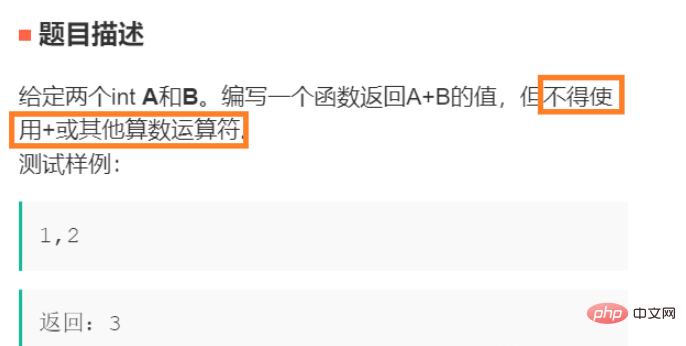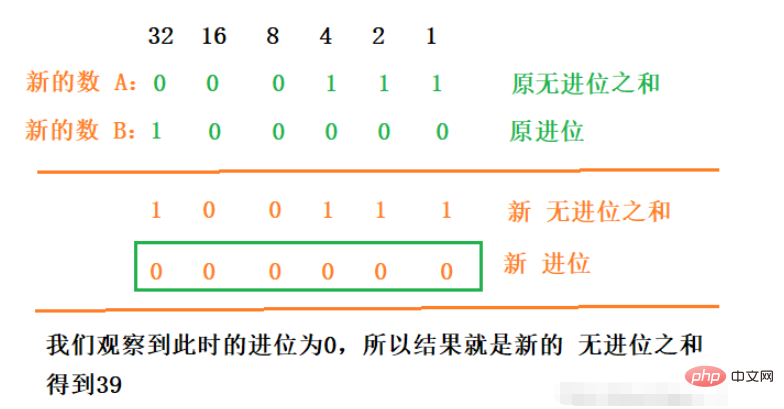How to implement summation in Java without arithmetic operators

The question says that arithmetic operators cannot be used, so we can only start with logical operators and shift operators.
We know that the ^ (XOR) operation is a carry-free sum of two numbers. If the addition of two numbers does not produce a carry, then the sum is the sum of the two numbers. This is the key to solving the problem. Generally speaking, adding two numbers will produce a carry. To get the correct sum, we should add a carry on the basis of the "sum without carry". Then we should first get the carry. We know that when the corresponding positions of the two numbers are both 1, a carry will occur. That is, under the condition that the corresponding positions A&B==1, we can get a carry for each bit, but the carry is to add this 1 to the corresponding higher digit, so we shift the obtained carry to the left by one digit, and then add it to the "sum without carry" obtained previously, to get the sum of the two numbers.
We find that we can have infinite matryoshka dolls here. To get the sum of "sum without carry" and "generated carry", then treat these two numbers as two new numbers respectively. For Its summation. The previous operation is also repeated until the two numbers cannot produce a carry, and the result can be obtained directly through the ^ operation.
Suppose we find the value of 23 16


public static int addAB(int A, int B) {
// 当两数的产生的进位为 0,就退出循环,返回其无进位和,就是结果
while ((A & B) != 0) {
int A_B = A ^ B;// 无进位求和
int AB = (A & B) << 1;// 得到进位
// 接下来就是求 得到的进位 + 无进位之和,重复前面的操作,直到不产生进位
A = A_B;
B = AB;
}
// 最后返回新的无进位之和
return (A ^ B);
}public static void main(String[] args) {
int count = 1_0000_0000;// 比较次数 100000000次
Random random = new Random();// 生成随机数字
boolean flag = true;// 相等则为 true
for (int i = 0; i < count; i++) {
int num1 = random.nextInt(Integer.MAX_VALUE/2);// 随机正数1
int num1_2 = random.nextInt(Integer.MAX_VALUE/2);// 随机正数2
// 随机正数1 + 随机正数2
if ((num1+num1_2) != addAB(num1,num1_2)){
// 有一次不相等的,则退出循环
flag = false;
break;
}
int num2 = -random.nextInt(Integer.MAX_VALUE/2);// 随机负数1
int num2_2 = -random.nextInt(Integer.MAX_VALUE/2);// 随机负数2
// 随机负数1 + 随机负数2
if ((num2+num2_2) != addAB(num2,num2_2)){
// 有一次不相等的,则退出循环
flag = false;
break;
}
int num3 = random.nextInt(Integer.MAX_VALUE);// 随机正数
int num4 = -random.nextInt(Integer.MAX_VALUE);// 随机负数
// 随机正数 + 随机负数
if ((num3+num4) != addAB(num3,num4)){
// 有一次不相等的,则退出循环
flag = false;
break;
}
}
System.out.println(flag);
}
The above is the detailed content of How to implement summation in Java without arithmetic operators. For more information, please follow other related articles on the PHP Chinese website!

Hot AI Tools

Undresser.AI Undress
AI-powered app for creating realistic nude photos

AI Clothes Remover
Online AI tool for removing clothes from photos.

Undress AI Tool
Undress images for free

Clothoff.io
AI clothes remover

AI Hentai Generator
Generate AI Hentai for free.

Hot Article

Hot Tools

Notepad++7.3.1
Easy-to-use and free code editor

SublimeText3 Chinese version
Chinese version, very easy to use

Zend Studio 13.0.1
Powerful PHP integrated development environment

Dreamweaver CS6
Visual web development tools

SublimeText3 Mac version
God-level code editing software (SublimeText3)

Hot Topics
 Square Root in Java
Aug 30, 2024 pm 04:26 PM
Square Root in Java
Aug 30, 2024 pm 04:26 PM
Guide to Square Root in Java. Here we discuss how Square Root works in Java with example and its code implementation respectively.
 Perfect Number in Java
Aug 30, 2024 pm 04:28 PM
Perfect Number in Java
Aug 30, 2024 pm 04:28 PM
Guide to Perfect Number in Java. Here we discuss the Definition, How to check Perfect number in Java?, examples with code implementation.
 Random Number Generator in Java
Aug 30, 2024 pm 04:27 PM
Random Number Generator in Java
Aug 30, 2024 pm 04:27 PM
Guide to Random Number Generator in Java. Here we discuss Functions in Java with examples and two different Generators with ther examples.
 Armstrong Number in Java
Aug 30, 2024 pm 04:26 PM
Armstrong Number in Java
Aug 30, 2024 pm 04:26 PM
Guide to the Armstrong Number in Java. Here we discuss an introduction to Armstrong's number in java along with some of the code.
 Weka in Java
Aug 30, 2024 pm 04:28 PM
Weka in Java
Aug 30, 2024 pm 04:28 PM
Guide to Weka in Java. Here we discuss the Introduction, how to use weka java, the type of platform, and advantages with examples.
 Smith Number in Java
Aug 30, 2024 pm 04:28 PM
Smith Number in Java
Aug 30, 2024 pm 04:28 PM
Guide to Smith Number in Java. Here we discuss the Definition, How to check smith number in Java? example with code implementation.
 Java Spring Interview Questions
Aug 30, 2024 pm 04:29 PM
Java Spring Interview Questions
Aug 30, 2024 pm 04:29 PM
In this article, we have kept the most asked Java Spring Interview Questions with their detailed answers. So that you can crack the interview.
 Break or return from Java 8 stream forEach?
Feb 07, 2025 pm 12:09 PM
Break or return from Java 8 stream forEach?
Feb 07, 2025 pm 12:09 PM
Java 8 introduces the Stream API, providing a powerful and expressive way to process data collections. However, a common question when using Stream is: How to break or return from a forEach operation? Traditional loops allow for early interruption or return, but Stream's forEach method does not directly support this method. This article will explain the reasons and explore alternative methods for implementing premature termination in Stream processing systems. Further reading: Java Stream API improvements Understand Stream forEach The forEach method is a terminal operation that performs one operation on each element in the Stream. Its design intention is






